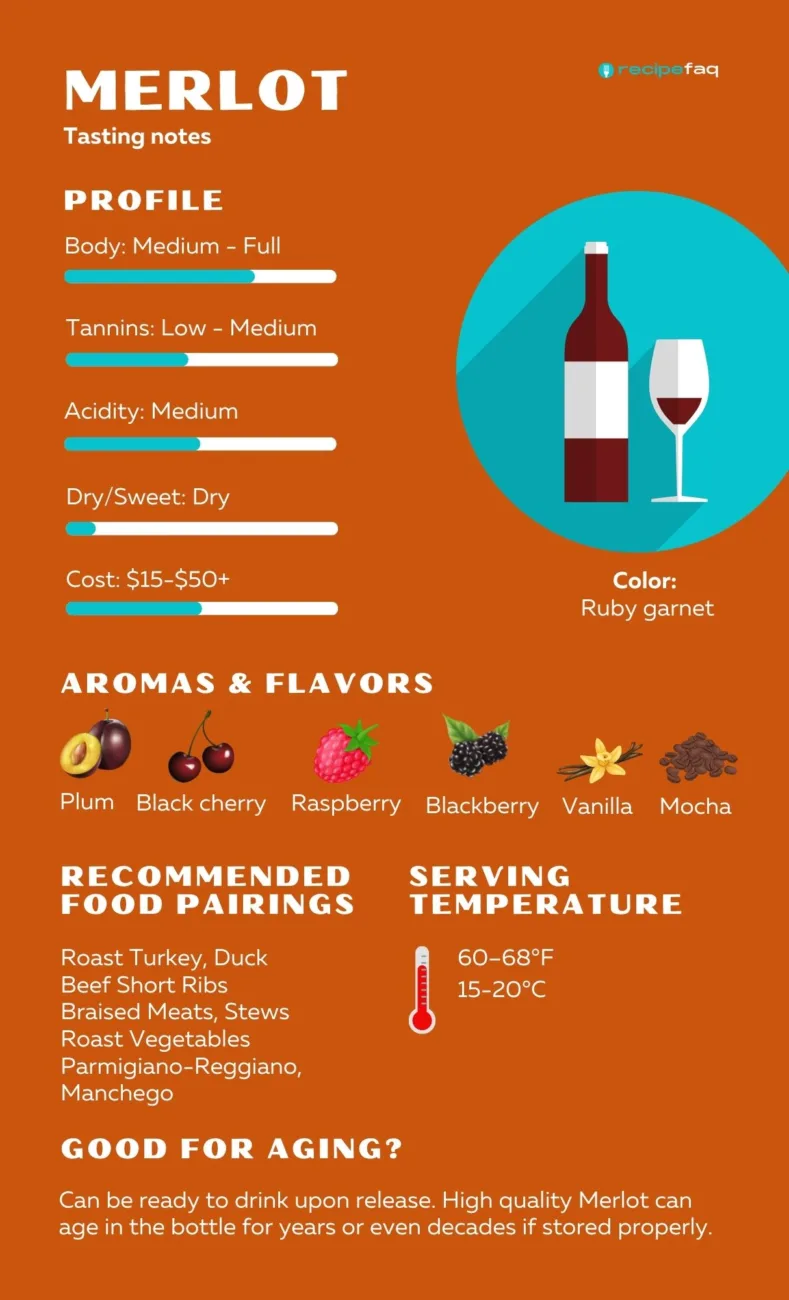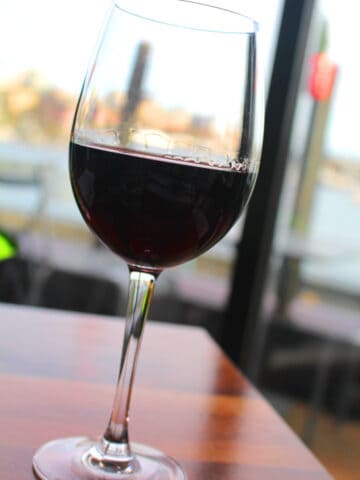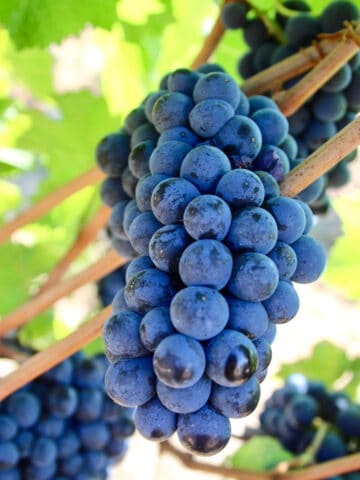When it comes to rich, full-bodied, red wines these are two of the most popular among wine enthusiasts. But they have unique qualities that set them apart. Discover some of the main differences between Malbec vs Merlot.

Malbec and Merlot. These two red grape varieties both have their roots in the Bordeaux region of France, but now the wines they produce are enjoyed the world over.
They make up two of the six Bordeaux red grapes — along with Cabernet Sauvignon, Cabernet Franc, Petit Verdot, and Carménère — which are used to create Bordeaux blends.
And while they share some similar characteristics, they each have distinct traits that make them unique — from flavor profile to aroma, body, and more.
So, what’s the difference between Malbec and Merlot? Read on to find out.


Jump to:
The origin of Malbec
Records show Malbec grapes being grown in the Cahors region of France as far back as the 1500s.
An outbreak of the parasite phylloxera in the 19th century dealt a blow to Malbec in Europe after it wiped out most of the region’s Malbec vineyards.
At around the same time, the grape was introduced to Argentina in an effort to improve the quality of that country’s wines. That began a shift in Malbec production from Europe to South America.
European Malbec production took another hit in 1956 when a severe frost threatened several vineyards in France. As a result, many winemakers decided to replant with Merlot, which is easier to grow.
However, Malbec continued to thrive in Argentina’s high altitude vineyards, particularly in the Mendoza region. Now Argentina is home to over 75% of the world’s Malbec grapes. These are often more fruit-forward and softer than French Malbecs, which tend to have harsher tannins.
Other growing regions include the United States, New Zealand, and Chile.
The origin of Merlot
Merlot also has its origins in France, specifically the Bordeaux region. The word “merlot” is a French term for blackbird, leading some to speculate that the name of the grape originally referred to its dark-colored skin.
Merlot dates back as far as the 14th century. By the late 18th century, it become one of Bordeaux’s most popular grape varieties, and it was gaining a reputation for producing high-quality wines.
The same 1956 frost that decimated Malbec in Bordeaux also destroyed numerous acres of Merlot. In 1970, several seasons of severe rot led to a ban on planting any new Merlot. But 5 years later, the ban was lifted and the grape began to gain in popularity once again.
By the 1980s, vineyards in the United States, particularly California, also began widely planting Merlot, leading to increased consumption outside of Europe.
Today, more than 650,000 acres of Merlot grapes are grown worldwide. That’s second only to Cabernet Sauvignon.
While it’s native to France, other major wine regions producing Merlot now include the United States, Italy, South Africa, Spain, and parts of South America.
Flavor characteristics and aroma
Malbec and Merlot are both fruit-forward, dry red wines, but each has distinct flavor profiles and aromas that distinguish them.
Malbec

Malbec is often described as “jammy.” That’s due in part to a prominent grape-forward taste, along with other dark fruit notes including plum, blackberry, and leather. Black pepper and spice are also common Malbec flavor characteristics.
Malbec wines generally have moderate tannins which result in dry wines, but with a medium finish.
You’ll often smell notes of blueberry and black cherry aromas with Malbecs. These slightly sweeter fruits help make the wine smell lighter than some other red wines such as Cabernet Sauvignon. But Malbec still has a rich, satisfying nose.
Merlot

Merlot has a rich flavor profile that includes dark fruit notes such as black cherry and raspberry. It also layers in flavors of vanilla and mocha that help mellow out the wine and give it a richer feeling.
Merlot aromas can often include black currant, caramel, cinnamon, and spices such as nutmeg and cardamom.
Like Malbec, Merlot also has medium tannins which help produce a softer, rounder feel and wines that are simply pleasurable to drink. These factors have helped contribute to its popularity.
Merlot blends are often created with Malbec, Cabernet Sauvignon, and Cabernet Franc.
Acidity
The acidity helps determine how a wine feels and tastes while you drink it. Wines higher in acid tend to coat the sides of your mouth and you might taste some tartness, especially in white wines. Lower-acid wines will feel smoother and softer when you drink them.
Wines produced in cooler climates will generally have more acidity as the lower temperatures slow ripening and reduce natural sugar levels in the grapes.
Malbec
Malbecs typically exhibit medium levels of acidity, as well as moderate levels of tannin. This means the wines often have a rounder mouthfeel.
Malbecs grown in cooler regions or at higher altitudes — such as many Argentine Malbecs from the Mendoza region — will usually have higher acidity.
Merlot
Similarly, Merlot wines have medium levels of acidity, but somewhat less tannin. While still considered dry, the soft tannins result in mellower, approachable wines which are widely appealing.
The moderate tannins and balanced acidity make Merlots ideal for pairing with various foods.
Body
Malbec’s firmer tannins and high alcohol levels help make them full-bodied wines.
Its complex flavor profile and dark color also contribute to its sense of depth and density.
Merlot ranges from more of a medium-bodied wine to full body, thanks in part to its medium to high alcohol levels. But its relatively low levels of tannin still give Merlots a smoother finish and give them an easy-to-drink quality.
Both Merlot and Malbec have alcohol contents ranging from about 13% to 14.5% ABV. Ones grown in warmer climates will typically have higher alcohol levels.
Color
Malbec and Merlot wines have deep, rich colors but Malbecs usually have a tell-tale distinction that makes them easily recognizable.

A rich purple color with hues of dark red is typical for Malbecs — colors that resemble their jammy flavor profile. When drinking Malbec, you can sense how the color works alongside the flavor and aroma to create a wine that is both rich and pleasantly fruity at the same time.
Merlot wine is also dark in color but is characterized as being more of a rich red. Though usually not as dark as a Cabernet Sauvignon, it is darker than other reds like Pinot Noir. Overall, Merlot still has an inviting deep red hue.
Aging
Many Malbecs and Merlots are sold as ready to drink or consumed soon after buying. If you plan to store them, opt for high-quality wines with more tannin. Over time, those tannins will smooth out and result in velvety, luscious wines.
Malbec
Typically, most Malbecs will drink very well after 5 years of aging. But more complex ones can age for up to 10 years or longer and result in a great-tasting wine. The more full-bodied ones will age better for longer if stored in a temperature-controlled environment.
Merlot
On average, it’s recommended that most Merlots are aged no longer than 3 to 5 years, primarily due to its softer tannins, as tannins help preserve wine for aging. But some high-quality Merlots can age well up to 10 years or longer, depending on body and storage environment.
Food pairings
Each of these bold reds goes great with red meat like steak, but certain other foods pair better depending on which wine variety you choose.

Malbec is a good choice for less-fatty cuts of meat like filet mignon and hanger steak. It can also be the perfect wine for game birds or game meats like venison. Roasted salmon and creamier cheeses like blue cheese also pair well with Malbec.
Dishes like roast duck, and braised pork or lamb, go well with Merlot. So do sweeter roast vegetables like squash and beets. Merlot is also a good wine for hard cheeses like Parmigiano-Reggiano and Manchego.
Price
You don’t need to spend a small fortune to find a good bottle of Malbec or Merlot. Many great wines can be found in the $15 range and most are suited to drink right away.
For ones you’re looking to store, the price point will likely be upwards of $25. Very good quality Merlots and Malbecs can fetch much higher figures.
Malbec vs Merlot summary
Malbec
- Primary growing regions: Argentina, France
- Worldwide growing acres: 106,000
- Body: Medium to full
- Color: Deep purple
- Acidity: Medium
- Flavor notes: Plum, blackberry, blueberry, black cherry, jam, and leather
- Cost: $15 for ready-to-drink Malbec; $25 and up for higher quality
Merlot
- Primary growing regions: France, United States, Australia
- Worldwide growing acres: 657,300
- Body: Medium to full
- Color: Deep, rich red
- Acidity: Medium
- Flavor notes: Black cherry, raspberry, vanilla, mocha
- Cost: $15 for ready-to-drink Merlot; $25 and up for higher quality
While these wines share some similarities, which one you prefer will depend on your individual taste preferences. If you lean toward softer, rounder wines, then you may opt for a Merlot. If you like jammier dry wine, then a Malbec may be for you. That’s one of the best parts of figuring out your specific wine preferences: trying various ones to see what clicks. And as long as you like it, then that’s all that really matters.
More wine tasting guides
Discover the flavor profiles and food pairings for other wines. Check out these posts.






Leave a Reply